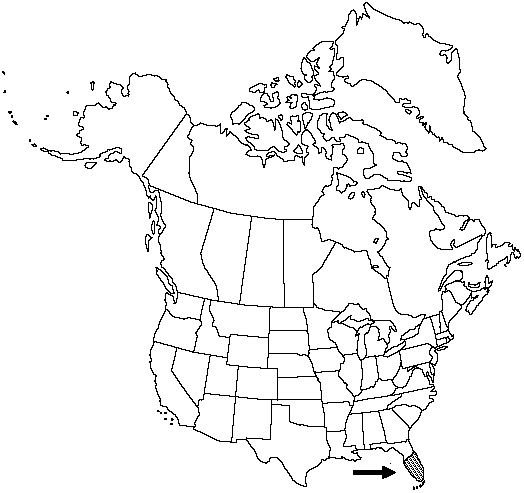Difference between revisions of "Nephrolepis biserrata"
Gen. Fil. plate 3. 1834.
FNA>Volume Importer |
imported>Volume Importer |
||
| (7 intermediate revisions by 2 users not shown) | |||
| Line 8: | Line 8: | ||
}} | }} | ||
|common_names=Giant sword fern | |common_names=Giant sword fern | ||
| − | |basionyms={{Treatment/ID/ | + | |basionyms={{Treatment/ID/Basionym |
|name=Aspidium biserratum | |name=Aspidium biserratum | ||
|authority=Swartz | |authority=Swartz | ||
| + | |rank=species | ||
| + | |publication_title=J. Bot. (Schrader) | ||
| + | |publication_place=1800(2): 32. 1801 | ||
}} | }} | ||
|synonyms= | |synonyms= | ||
| Line 20: | Line 23: | ||
}}<!-- | }}<!-- | ||
| − | --><span class="statement" id="st- | + | --><span class="statement" id="st-undefined" data-properties=""><b>Stem </b>scales loosely appressed to spreading, concolored or bicolored with pale margins. <b>Tubers</b> absent. <b>Leaves</b> 2–22 × 0.3–3.5 dm. <b>Petiole</b> 0.2–5.4 dm, sparsely to moderately scaly; scales spreading, reddish to light brown throughout (rarely with pale margins). <b>Blade</b> sparsely to densely scaly, glabrous or pubescent, hairs mostly on veins and abaxial, pale to light brown, 0.2–0.7 mm. <b>Rachis</b> 1.8–17 dm, points of pinna attachment 7.5–35 mm apart; scales moderately spaced, pale brown throughout. <b>Central</b> pinnae narrowly deltate to narrowly elliptic-lanceolate, 2.5–23 × 0.5–2 cm, base cuneate, truncate to auriculate-cordate acroscopically, rounded basiscopically, acroscopic lobe small and oblong or absent, margins biserrate to serrulate, apex attenuate; costae adaxially glabrous or densely hairy, hairs erect, pale, 0.3 mm. <b>Indusia</b> circular to horseshoe-shaped, peltate or attached at narrow sinus, 0.8–1.1 mm wide. <b>2n</b> = 82.</span><!-- |
-->{{Treatment/Body | -->{{Treatment/Body | ||
| Line 26: | Line 29: | ||
|elevation=0 m | |elevation=0 m | ||
|distribution=Fla.;Mexico;West Indies;Central America;South America;Africa;se Asia. | |distribution=Fla.;Mexico;West Indies;Central America;South America;Africa;se Asia. | ||
| − | |discussion=<p>Some forms of Nephrolepis biserrata closely resemble N. multiflora in pinna shape and indument but lack the distinctively transparent-margined (i.e., bicolored) and persistent petiole scales of the latter species. Nephrolepis multiflora also has more appressed and darker-colored stem scales.</p> | + | |discussion=<p>Some forms of <i>Nephrolepis biserrata</i> closely resemble <i>N. multiflora</i> in pinna shape and indument but lack the distinctively transparent-margined (i.e., bicolored) and persistent petiole scales of the latter species. <i>Nephrolepis multiflora</i> also has more appressed and darker-colored stem scales.</p> |
|tables= | |tables= | ||
|references= | |references= | ||
| Line 35: | Line 38: | ||
-->{{#Taxon: | -->{{#Taxon: | ||
name=Nephrolepis biserrata | name=Nephrolepis biserrata | ||
| − | |||
|authority=(Swartz) Schott | |authority=(Swartz) Schott | ||
|rank=species | |rank=species | ||
| Line 49: | Line 51: | ||
|publication year=1834 | |publication year=1834 | ||
|special status= | |special status= | ||
| − | |source xml=https:// | + | |source xml=https://bitbucket.org/aafc-mbb/fna-data-curation/src/2e0870ddd59836b60bcf96646a41e87ea5a5943a/coarse_grained_fna_xml/V2/V2_136.xml |
|genus=Nephrolepis | |genus=Nephrolepis | ||
|species=Nephrolepis biserrata | |species=Nephrolepis biserrata | ||
| − | |||
| − | |||
| − | |||
| − | |||
| − | |||
| − | |||
| − | |||
| − | |||
| − | |||
| − | |||
| − | |||
| − | |||
| − | |||
| − | |||
| − | |||
| − | |||
| − | |||
| − | |||
| − | |||
| − | |||
| − | |||
| − | |||
| − | |||
| − | |||
| − | |||
| − | |||
| − | |||
| − | |||
| − | |||
| − | |||
| − | |||
| − | |||
| − | |||
| − | |||
| − | |||
}}<!-- | }}<!-- | ||
-->[[Category:Treatment]][[Category:Nephrolepis]] | -->[[Category:Treatment]][[Category:Nephrolepis]] | ||
Latest revision as of 20:21, 5 November 2020
Stem scales loosely appressed to spreading, concolored or bicolored with pale margins. Tubers absent. Leaves 2–22 × 0.3–3.5 dm. Petiole 0.2–5.4 dm, sparsely to moderately scaly; scales spreading, reddish to light brown throughout (rarely with pale margins). Blade sparsely to densely scaly, glabrous or pubescent, hairs mostly on veins and abaxial, pale to light brown, 0.2–0.7 mm. Rachis 1.8–17 dm, points of pinna attachment 7.5–35 mm apart; scales moderately spaced, pale brown throughout. Central pinnae narrowly deltate to narrowly elliptic-lanceolate, 2.5–23 × 0.5–2 cm, base cuneate, truncate to auriculate-cordate acroscopically, rounded basiscopically, acroscopic lobe small and oblong or absent, margins biserrate to serrulate, apex attenuate; costae adaxially glabrous or densely hairy, hairs erect, pale, 0.3 mm. Indusia circular to horseshoe-shaped, peltate or attached at narrow sinus, 0.8–1.1 mm wide. 2n = 82.
Habitat: Terrestrial or less commonly epiphytic in forested, relatively wet habitats, e.g., swamps, but occasionally thickets, roadsides, or clearings
Elevation: 0 m
Distribution

Fla., Mexico, West Indies, Central America, South America, Africa, se Asia.
Discussion
Some forms of Nephrolepis biserrata closely resemble N. multiflora in pinna shape and indument but lack the distinctively transparent-margined (i.e., bicolored) and persistent petiole scales of the latter species. Nephrolepis multiflora also has more appressed and darker-colored stem scales.
Selected References
None.